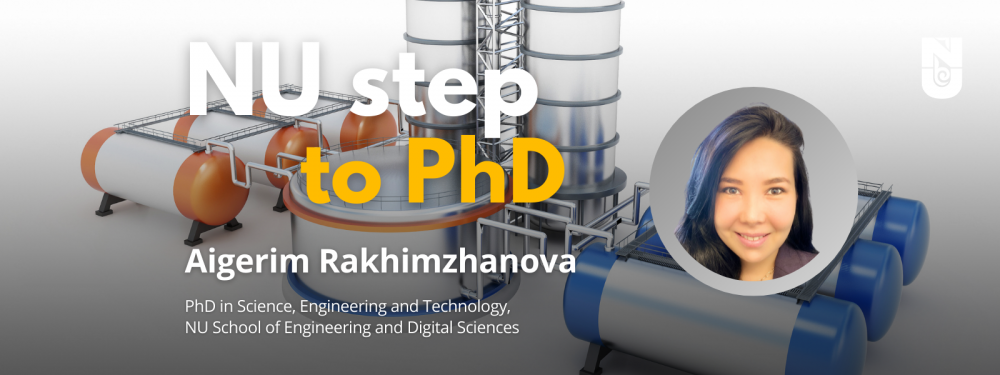NU Step to PhD: Aigerim Rakhimzhanova,PhD graduate in Science, Engineering and Technology
Our next NU Step to PhD guest is Aigerim Rakhimzhanova, a PhD graduate in Science, Engineering and Technology at NU SEDS. Aigerim is currently working as a research fellow in the program named after Maria Sklodowska-Curie at the University of Newcastle, UK, and she is conducting research for the European Commission as part of the Horizon 2020 project on Earth Science and Climate Change.
Tell us about your doctoral research?
In my doctoral study, I was engaged in 3D computer modeling of sand production in oil wells. Sand production is the most common problem in the oil and gas industry. For various reasons, sandstone particles break down and rise up in the well, filling it with sand. This leads to the deterioration or blocking of the oil and gas flow, and to the degradation of the equipment as well.
The oil industry loses millions of dollars annually in an effort to clean up the sand. In the worst case scenario, the lifetime of the well could be shortened, or the well’s use is terminated.
I have developed a new contact model for the computer calculation of sand rocks. Additionally, I’ve built an innovative computer model which mimics, as close as possible, the conditions of a real oil well and reservoir, which makes it possible to determine the causes and mechanisms of sand occurrence.
My work proved that computers have a tremendous ability to see in detail. For instance, some geomechanics occurs at a depth of 100-1000 meters below the Earth’s surface in micro and macro scales that humans cannot see, but that the computer can detect. The results of my research showed that the proposed model is useful for modeling sand production in oil wells.
What is the applied value of your work?
There were two innovative novelties in my work: a contact model for the computer calculation of sand rocks, and an innovative model for determining and predicting the mechanisms of sand occurrence in oil wells.
The contact model for sand rocks which I built makes it possible to develop a prototype of real sandstones from different parts of the Earth, and to obtain more detailed information about the mechanical and material characteristics of rocks by modeling the necessary processes. The proposed model for determining and predicting the mechanisms of sand occurrence in oil wells can be used in practice by= existing wells, regardless of the depths of the oil and gas deposits.
What can you tell us about the process of writing your thesis?
I divided the process of studying in my doctoral program into several goals to achieve and stages in order to become a highly qualified expert in my industry, and improve not only my technical skills knowledge in this sphere but also my professional values and skills.
These goals were:
- building cooperation with top-level universities and professors in my field of research,
- publishing results in international journals with a high impact factor,
- presenting my papers at international conferences and gaining experience in international research projects.
As a result, my supervisor was a world-class professor and a pioneer in the sphere of computer modeling using the discrete element method: Professor Colin Thornton from the University of Birmingham. I am so grateful to him for teaching me computer modeling in the field of Earth science and geotechnics from scratch. I have published two articles in top journals and presented the results at international conferences in the USA and in Argentina. I have managed to work as a researcher at the Maria Sklodowska-Curie Program at the University of Warwick, University College London, and the University of Newcastle. Working in collaboration with professors from the above universities, I gained excellent experience and knowledge and received advice in my field, which has helped me to conduct high-quality research and write my doctoral thesis.
I am immensely grateful to my supervisors for their mentorship. Special thanks to the director of the program, Professor Luis Rojas, who prepared all the candidates for the defense of their doctoral dissertation. I am very glad that I met very interesting, intelligent, and talented doctoral students of Nazarbayev University, with whom I keep in touch to this day.
Please, tell us about your future plans?
Now I am a researcher at Newcastle University, working in the Maria Sklodowska-Curie Program, which is one of the most competitive and prestigious European research and innovation programs. I am conducting research for the European Commission in the framework of the Horizon 2020 project in the field of Earth science and climate change. In the future, I would like to continue researching on climate change, as I want the results of my work to benefit nature and humanity.
What would you advise to future doctoral students?
Writing a doctoral dissertation is a very difficult and painstaking process that requires a PhD candidate to have not only knowledge, experience and skills in his field of research, but also to be able to comply with the many requirements.
I wish all future doctoral students to find an interesting topic for their study, so that their chosen field of research coincides with their dreams and purposes, as well as to produce fruitful work, and to have the patience and resilience to be up for such a challenge.


